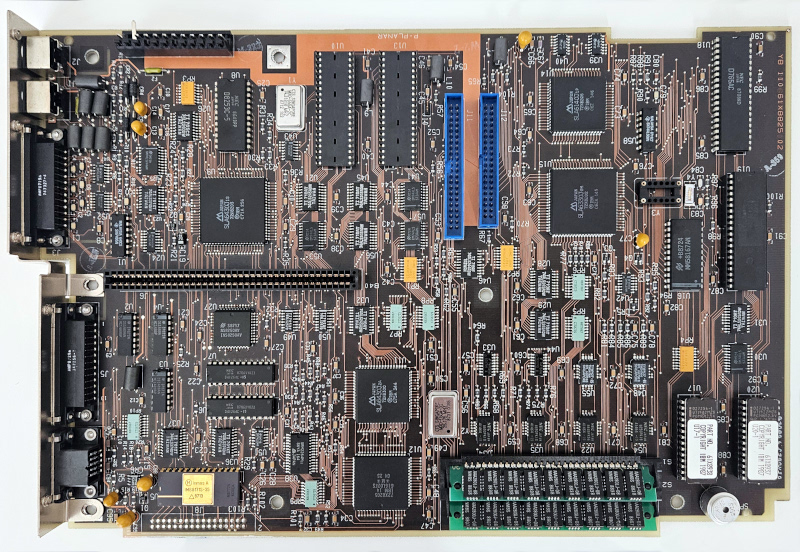IBM PS/2 Model 30 8530 P-Planar


Rules exist for a reason, and breaking them has consequences.
In the realm of computing, I've found it beneficial to maintain a distance from major North American brands like IBM, Compaq, DEC, Apple, Dell, HP, Gateway 2000, and so on.
IBM's Model 30 boards were once so common that they can still be acquired inexpensively today. Decided to examine one, specifically the Model 8525.
It features a non-standard power connector, which mostly aligns with the AT standard except for one pin that needs to be changed from +5V to GND.
Notice how on the brown board, this pin is bent, and it is entirely missing on the green board (it broke off).
The 8525 board never functioned correctly; I couldn't test anything on it, and it eventually stopped working altogether. I didn't attempt to repair it because I didn't know where to start. It is now with another forum member. Hope he resurrects it.
I acquired a second board, the green 8530 mentioned above. This one worked well initially. Early tests showed good structural and functional integrity, but it didn't overclock well, which is important to me.
At approximately 11MHz, the keyboard controller would hang the system during boot. Tried different KBC chips, but the assembly only accepted type 5 controllers, regardless of brand. This was unusual but manageable. I found a few different chips from AMI, Intel, and NEC, but none could overcome the 11.68MHz limit set by the 70MHz oscillator with a frequency divider of 6. The board accepted the NEC V30 CPU without issue, which can exceed its 16MHz rating, but running it at mere 11MHz frustrating.
Eventually, I realized the system clock oscillator (in the upper right corner) could be hot-swapped after booting to DOS. I used a frequency multiplier from Migron that fits a can-4 socket. This resulted in 24.535*3.33 = 13.68MHz. Better, but far from great.
The next logical step was to see if the 150ns on-board RAM chips were too slow. It was unlikely but who knows really. Replaced the four 41464 chips with 80ns versions, and the board died. Hard. Couldn't revive it. Cannot identify what and where went wrong.
I'm decently skilled with tools and electronics repair, so I know it wasn't due to carelessness. I was particularly cautious because, with two boards, I noticed how poorly constructed they are. The PCB is flimsy, bends, bubbles and melts even with modest heat gun use.
Acquired a third board, the brown one above.
Interestingly, it didn't power up with the NEC V30 CPU, which was unexpected. After probing with an oscilloscope, I determined the issue was likely related to the 72X8202 chip. Notably, these chips differ between the two boards.
Initially, the Japan-made SLA6330J was on the now-dead green board.
Swapped the chips, which caused the brown board to fail too. This was baffling. Probing with a multimeter confirmed all pins were properly soldered, but some signals were apparently incorrect. I had some flux residue around the swapped chip and between its pins. This had never been an issue before, so I initially dismissed it, but eventually, I decided to clean it off. Hot water and a brush do the job. After drying the board and plugging it in, it worked immediately. This was perplexing.
The brown board with the NEC V30 CPU was still limited to no more than 13.68MHz. I captured results from standard benchmarks at 10MHz (normalized) and peak 13.68MHz, but performance was meh. Decided to carefully upgrade the on-board RAM. After doing so, the board failed, just like the green one.
Very frustrating, but got the memo and decided to stop here.
So, let's summarize:
8525: Odd power connector that maps to AT. No MCGA connector, only on-board pins for it. DIP on-board RAM, making it easy to upgrade with faster chips.
8530: Standard AT power connector, easy to use. Proper MCGA connector, easy to use. PLCC on-board RAM, difficult to upgrade.
Poor PCB quality.
Limited to one type of keyboard controller.
Some boards don't support NEC V30 CPU upgrades.
Sensitive signal processing; even flux presence disrupts signal integrity.
I usually respect and appreciate these vintage electronics and the engineering behind them, but the IBM Model 30 motherboards are just too bad. I hesitate to call them garbage, but will refrain from doing so. Anyhow.
Tested with:
NEC V30 16MHz
Diamond SpeedStar 24 (ET4000AX)
640KB RAM (first 128KB are 150ns, the rest are two sticks with 80ns chips)
XT-IDE controller with CF, DOS 4 and 6.22 (no performance difference)

Performance is unimpressive for an 8086/V30 system.
benchmark results
---
EDIT: If somebody wants these motherboards - PM me and they will be yours for a shipping cost.


